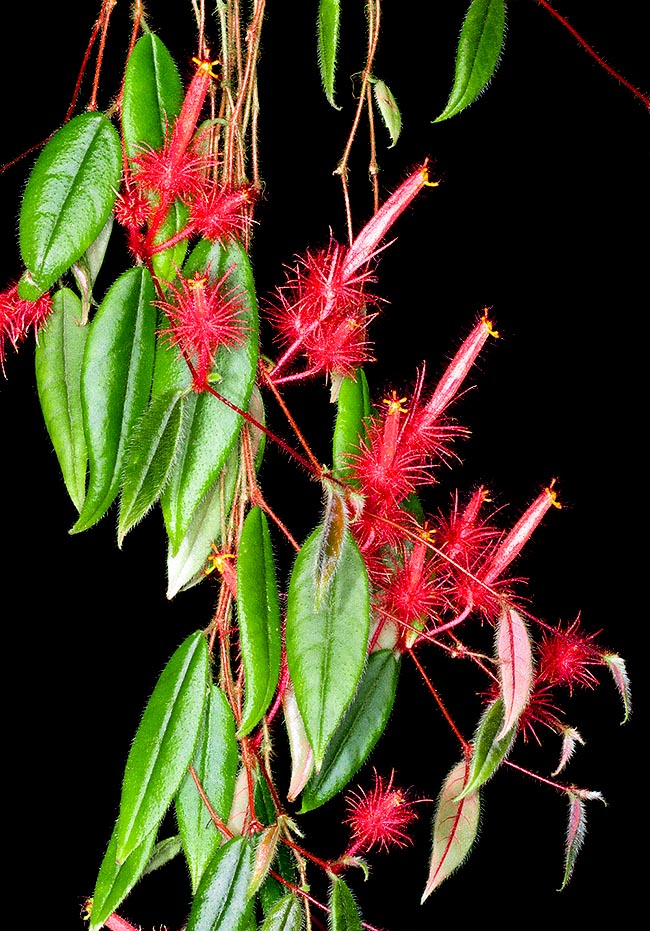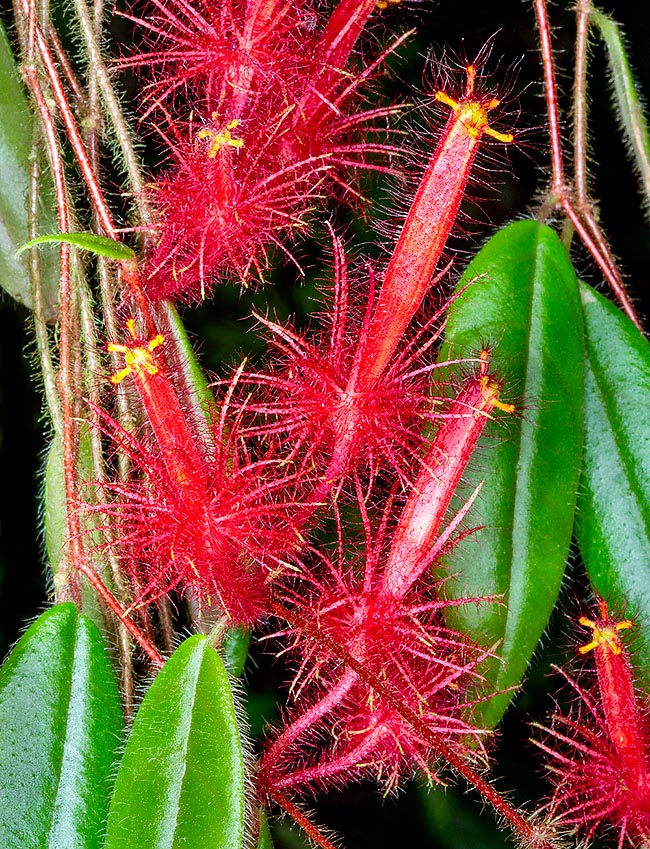Family : Gesneriaceae

Text © Pietro Puccio

English translation by Mario Beltramini

The Columnea minor is a very variable epiphyte herbaceous species, present in Colombia and Ecuador forests. The stems, usually drooping, reach even the 15-70 cm, or more, with neatly unequal opposite leaves © Giuseppe Mazza
The species is native to Colombia and Ecuador, where it grows on the trees of the humid forests between 800 and 2000 m of altitude.
The genus is honoured to the Italian naturalist Fabio Colonna (1567-1640): the name of the species is the Latin adjective “minor” = minor, given to distinguish it from the species to which was given the specific name “major” = major.
The Columnea minor (Hook.) Hanst. (1866) is a very variable herbaceous epiphyte species with not ramified thin stems, of 2-3 mm of diameter, usually drooping, 15-70 cm or more long, rooting at the nodes, spaced of 3-12 cm, reddish and covered by thin hair having the same colour, 3-5 mm long.
Opposite leaves neatly unequal, the biggest one, on a 0,6-1,3 cm long hirsute petiole, simple, drooping, elliptic to lanceolate with long acuminate apex and slightly toothed margin, 5-15 cm long and 3-7 cm broad, rather coriaceous, of intense green colour above, clear green at times suffused of red below, covered by thin transparent 4-5 mm long hair; the smallest, precociously deciduous, subsessile, ovate-lanceolate, 0,5-3 cm long and 0,3-1 cm broad, hirsute like the bigger one.
Solitary or 2-4 flowers at the axil of the leaves, peduncle, 1,5-3,5 cm long, reddish, thickly covered by hair of the same colour, calyx with 5 slightly unequal lobes, 1,5-3 cm long, deeply incised in thin segments (laciniae), of pink or red colour, hirsute.
Tubular corolla with 4-5,5 cm long tube and of 0,6-0,8 cm of diameter in the central part, slightly narrow at the apex, red to dark purple, thickly covered by hair of the same colour, 5 unequal lobes of yellow colour, ovate or semicircular, 2-4 mm long, the upper two partially merged, hirsute outside, 5 appendages of yellow colour, 2-4 mm long ans 0,5 mm broad, hirsute at the apex, 4 stamens and superior ovary.
The fruits are globose berries, of about 1 cm of diameter, fleshy, of pinkish colour.

Unmistakable purple flowers with hirsute calyx with a 5 yellow lobes tubular corolla © Giuseppe Mazza
It reproduces by seed, put in draining organic loam maintained humid at the temperature of 22-24 °C, and by cutting, even tip.
Considered of not too easy cultivation, it is to be placed in suspended pots, utilizing a very aerated and draining organic loam, in very luminous environment, even with some hours of sun in the morning, cool and aerated, without changes in temperature, with high atmospheric humidity, 65-80 %.
Watering must be regular, but without stagnations, utilizing rain water, de-mineralized or by reverse osmosis at room temperature, slightly more spaced in winter in order to allow the compound to dry up partially before giving water again.
For the fertilizations, in spring summer, a specific product for epiphyte orchids may be utilized.
Synonyms: Trichantha major Hook. (1844); Trichantha minor Hook. (1844); Columnea major (Hook.) Hanst. (1866); Columnea martiana Kuntze (1891); Trichantha bullata C.V. Morton (1963); Trichantha clara C.V. Morton (1963); Trichantha elegans Rose ex C.V. Morton (1963); Trichantha teuscheri C.V. Morton (1963); Trichantha tropicalis C.V. Morton (1963); Columnea teuscheri (C.V.Morton) H.E.Moore (1965); Columnea bullata (C.V.Morton) C.V.Morton (1971); Columnea elegans (Rose ex C.V.Morton) C.V.Morton (1971); Ortholoma tropicale (C.V. Morton) Wiehler (1971); Ortholoma clarum (C.V. Morton) Wiehler (1973); Ortholoma minor (Hook.) Wiehler (1973).
→ To appreciate the biodiversity within the GESNERIACEAE family please click here.
